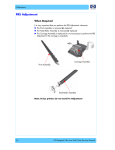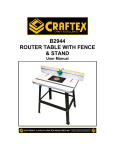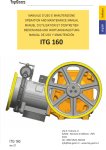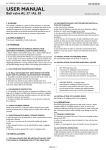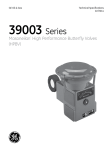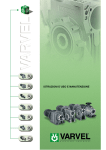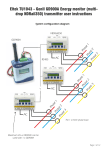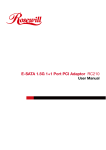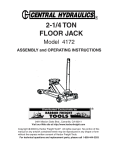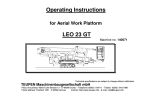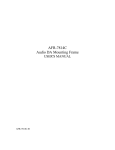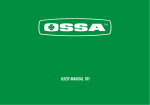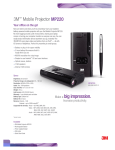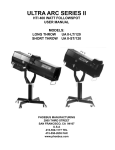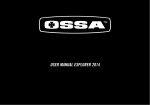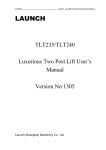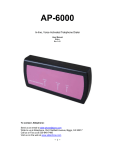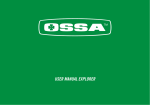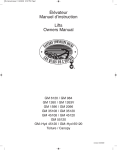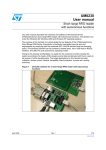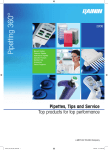Download Instruction - Axel Larsson Maskinaffär AB
Transcript
Top Quality Valve Actuators Made in Sweden Ref. 5.400B_UK - 04/2012 www.axel-larsson.se USER MANUAL RC200 Instruction Pneumatic actuator - AL 77-200 Manufacturer: Rotork, Sweden Original type: RC Pneumatic Actuators Type and Design Manual Operation DA = Double Acting. Actuator with pneumatic operation in both directions. SR = Spring Return. Actuator with spring return. RC 210, 230, 250 and 270 have 1 piston. RC 220, 240, 260, 265 and 280 have 2 pistons. WARNING! Operating Medium If the operating medium is instrument air, it shall be dust and oil-free. Accepted operating medium: Non-dangerous fluids (group 2 according to directive 97/23/EC). The dew point shall be equal to –20 °C or, at least, 10 °C below the ambient temperature. The maximum particle size must not exceed 40 μm. The exhaust air must pass through a filter silencer before it is let out into the workshop. The Application of the Scotch Yoke Construction RC actuators must only be used as actuators on valves. Levers, racks and similar cannot be used to transmit movement without protective equipment. Pinch risk in the valve opening when test trimming non-installed valves. The actuator can be equipped with handwheel for manual operation, RC-M1. Other methods on request. WARNING! All manual operations must be carried out with a vented actuator. The Scotch Yoke of the RC200 actuators has canted slots. Thus the actuator can be given different function depending on how the pistons are mounted in the actuator. The pistons are mounted according to Fig.1, page 2, or Fig.1a, in order to achieve the following functions. According to Fig.1: DA-Actuator with adjustable closed valve position (clockwise end of travel). SRF-Actuator with spring opening (counter clockwise direction), adjustable “closed” valve position (clockwise end of travel). According to Fig.1a: DAAO-Actuator with adjustable open valve position (counter clockwise end of travel). SR-Actuator with spring closing (clockwise direction), adjustable “open” valve position (counter clockwise end of travel). The possibility to turn the pistons can be used in several ways in order to suit the actuators to the customer’s requirements. WARNING! It is very risky to try to operate the actuator manually by using the key grip on the driving shaft. The accumulated energy inside the actuator may instantaneously be set free. Installation and Adjustment All types of actuators can be mounted in various positions, e.y. vertical or horizontal. When mounting on a valve, ensure that the actuator shaft and the valve stem are centered, and that a play of 0,5-1 mm exists between shaft and driving bush depending on actuator size. Ensure especially that actuator and driving bush are mounted correctly in relation to eachother, considering that the actuator shaft has an octagonal hole and that a faulty mounting of 45° is possible. This naturally also applies to direct mounting on a valve.The guide ring (37) can be dismantled when not in use. After mounting, it may be necessary to adjust the turning angle of the actuator. Tightening torques for lock nuts on page 6. As mentioned previously, the DA actuators can, as standard, be adjusted in ”closed” valve position and the SR actuators in ”open” position. The adjustment occurs by loosening the lock nut on the end plate, after which the set screw is turned clockwise for reduced and anti-clockwise for increased rotary motion. The adjustment degree is ±3°. RC220, 240, 260 and 280 have two adjustment screws. It is important that both screws are in contact with the piston in question. The actuator is supplied with an indicator on the driving shaft. The indicator can be mounted in 2 optional positions for different valve functions, mounting directions, etc. www.remotecontrol.se 5.400B_UK - 1 Ref. 5.400B_UK - 04/2012 www.axel-larsson.se USER MANUAL Pneumatic actuator - AL 77-200 4 6 12 34 20 21 31 27 18 32 19 Manufacturer: Rotork, Sweden Original type: RC Fig. 1a 33 16 1 2 3 5 14 10 Fig. 1 9 11 8 35 36 15 39 38 37 40 WARNING! 22 23 6 25 28 30 29 Dwg 007469 Service of RC210-280 Before dismantling, check that the compressed air and possible power supply are disconnected. Dismantling of SR unit, see instruction on page 5. Dismantling of SR unit with manual operation unit type M1, see instruction on page 4. Exchange of Piston Sealings and Support Elements 1. 2. 3. 4. 26 Please read the warning above! Dismantle the actuator from the console. Dismantle the end plates (5) or the spring houses (25). Fasten the actuator shaft between soft jaws in a vice and turn the actuator until the pistons reach the cylinder end. Then place a few rods in the holes on the outside of one piston. By pressing together and pulling these rods simultaneously, the piston is dismantled from the cylinder. 5. If the piston O-ring (12) is worn, it must be replaced. 6. Replace the support band (14) if it is worn. 7. Replace the support element (9) if it is worn. 8. Grease the cylinder surface with a grease according to the lubrication list on page 6. 9. Fit piston/s correctly positioned, see “The Application of the Scotch Yoke construction“. 10. Fit the end plate/s or spring pack/s and adjust the shaft turning angle. Exchange of Shaft Sealings and Support Washers The O-rings (18) and (38) and the support washers (33) and (39) can easily be replaced as below. 1. Please read the warning on the left! 2. Dismantle the actuator from the console. 3. Dismantle the retaining rings (31) and (40) around the shaft. 4. Dismantle the worn details. 5. Fit the new O-rings (18) and (38). 6. Fit new washers under the retaining rings. 7. Use a grease according to the lubrication list on page 6 when mounting. 8. Fit the new retaining rings. 9. Check that the retaining rings are tightly fitted without play in their grooves. Exchange of Shaft Bearings The bearings (16) and (36) and also the support ring (19) on the RC210-240 can easily be replaced when the pistons and shaft sealings are dismantled as above. For larger actuators, please contact the supplier. 5.400B_UK - 2 www.remotecontrol.se Ref. 5.400B_UK - 04/2012 www.axel-larsson.se USER MANUAL Pneumatic actuator - AL 77-200 Manufacturer: Rotork, Sweden Original type: RC Material Table for RC210-280 Part No Number Number DA SR Description Material Surface treatment 1 Adjusting screw1 1 - 2 Lock nut1 1 - 3 O-ring1,6 1 - 4 Screw 8-16 8-16 5 6 7 8 9 10 11 12 14 End plate with centre hole O-ring6 Cylinder Scotch Yoke Support element1,6 Piston1 Roll pin, double2,3 O-ring1,6 Support band1,6 1 2 1 1 1 1 1 1 1 2 1 1 1 1 1 1 1 15 Driving shaft 1 1 Size 210–260: Stainless steel Others: Steel Size 210–260: Stainless steel Others: Steel Nitrile Size 210–260: Stainless steel Others: Steel Aluminium Nitrile Aluminium Steel POM Aluminium Spring steel Nitrile Polymer material Size 210–260: Stainless steel Others: Steel 16 1 1 Polymer material 1 1 Aluminium Powder coated 18 19 20 21 22 23 24 25 Bearing, upper End plate without centre hole4 O-ring, upper6 Support ring, upper Piston pin1 Piston roller1 Spring guide1 Spring, external1 Spring, internal1,5 Spring housing1 Zinc plated Zinc plated Zinc plated Powder coated Anodized Zinc plated, yellow chromated - 1 1 1 1 - 1 1 1 1 1 1 1 1 26 Pre-tensioning screw1 - 1 27 28 Indicator O-ring1,6 1 - 1 1 29 Lock nut1 - 1 30 31 32 33 Marking washer1 Retaining ring, upper6 Middle washer6 Support washer, upper6 1 1 1 1 1 1 1 34 Sealing1 1 1 35 36 37 38 39 40 Support ring, lower Bearing, lower Guide ring O-ring, lower6 Support washer, lower6 Retaining ring, lower6 1 1 1 1 1 1 1 1 1 1 1 1 Nitrile Polymer rmaterial Steel Steel Aluminium Alloyed spring steel Alloyed spring steel Aluminium Size 210–260: Stainless steel Others: Steel Polymer material Nitrile Size 210–260: Stainless steel Others: Steel Aluminium Spring steel Stainless steel Polymer material, chemically resistant Size 210–240: Stainless steel Others: Nitrile Polymer material Polymer material Polymer material Nitrile Polymer material, chemically resistant Spring steel Corrosion protected Corrosion protected Powder coated Zinc plated Zinc plated Anodized Corrosion protected Corrosion protected 17 1 1) For actuator sizes 220, 240, 260 and 280: The double amount of details. 2) RC240 has triple roll pins. 3) RC270–280 have a slotted pin in steel. 4) Not in the picture! Do not exist for sizes 220, 240, 260 and 280. 5) Only for sizes 270 and 280, not in the picture. 6) Included in seal kit. 5.400B_UK - 3 Ref. 5.400B_UK - 04/2012 www.axel-larsson.se USER MANUAL Pneumatic actuator - AL 77-200 Converting to SR Actuators Manufacturer: Rotork, Sweden Original type: RC Fig. 2 All DA actuators can be changed into SR actuators by adding spring conversion kits according to the following instruction: 1. Please read the warning on page 2! 2. Dismantle the end plates. (The description is for RC220, 240, 260 and 280 which have two pistons). 3. Dismantle the pistons. See text under ”Exchange of piston sealings and support elements”. 4. Mount the pistons according to figure 1 on page 2. 5. Check that the spring is correctly pre-tensioned according to table 1 and figure 2. 6. The spring guide (22) is centered towards the piston with the aid of 2 pins. 7. The SR units on sizes 230–280 must be turned so that one of the three support points lies between the bosses on the piston (10). 8. Mount the SR unit when the pistons are in their innermost position. 9. Put the screws (4) in place. When tightening the screws, the spring force is transmitted from the tensioning screw (26) to these screws. Tightening torques according to table on page 6. 10. The turning angle of the actuator is adjusted with the tensioning screw (26). Adjustment is made with screw (26). Table 1 RC200-SR actuator A RC210-220 41 RC230-240 62 RC250-260 87 RC270-280 137 Instructions for Dismantling of RC200-SR Actuators with Manual Operation Unit Type M1 Fig. 3 WARNING! Do not remove the protective tube (50) and handwheel from the spring housing as long as the springs are tensioned. This procedure must be followed for safe dismantling of pre-tensioned spring housings. 1. The actuator must be pressureless. 2. Check that the springs can press the piston back into its starting position according to figure 3. The upper shaft journal must not be oblique. 3. Disconnect possible power supply. 4. Turn the handwheel so that the threaded stem (51) moves toward the actuator until it stops and the yellow marker (68) can just barely be seen in the plastic tube (49). 5. For sizes RC220, 240, 260 and 280 (i.e. actuators with two pistons): adjust the tensioning screw (26) in the opposite spring housing anti-clockwise until it lies against the spring guide (22). Dismantle the spring housing by loosening the screws (4). 6. For all sizes: then turn the handwheel until there is resistance and the yellow marker (68) can be seen within the ”AUTO” position. 7. Dismantle the spring housing of the manual override by loosening the retaining screws (4) and turning the handwheel several turns in the direction which gives the least resistance. Dismantling must be carried out in the above order with the utmost care. In the case of the slightest uncertainty contact the supplier. 5.400B_UK - 4 Ref. 5.400B_UK - 04/2012 www.axel-larsson.se USER MANUAL Pneumatic actuator - AL 77-200 Manufacturer: Rotork, Sweden Original type: RC Instructions for Dismantling of RC200-SR Actuators RC 210, 230, 250 and 270 WARNING! The procedure below must be followed for safe dismantling of pretensioned spring housings. 1. The actuator must be pressureless. 2. Check that the springs can press the piston into starting position according to figure 4. 3. Disconnect all possible power supply. 4. Loosen the lock nut (29). 5. Turn the tensioning screw (26) anticlockwise until it lies lightly against the spring guide (22). 6. Dismantle the spring housing by loosening the screws (4). 7. Dismantling must be carried out with the utmost care. In the case of the slightest uncertainty - contact the supplier. Fig. 4 WARNING! RC 220, 240, 260 and 280 The procedure below must be followed for safe dismantling of pretensioned spring housings. Fig. 5 5.400B_UK - 5 www.remotecontrol.se 1. The actuator must be pressureless. 2. Check that the springs can press the piston into starting position according to figure 5. 3. Disconnect all possible power supply. 4. Loosen the lock nuts (29). 5. Turn both spring tensioning screws (26) clockwise until they lies lightly against the spring guides (22). 6. Turn the left spring tensioning screw (26) anti-clockwise until it lies lightly against the spring guide (22) and dismantle the left spring housing by loosening the screws (4). 7. Dismantle the right spring housing in the same manner as the left one. 8. Dismantling must be carried out with the utmost care. In the case of the slightest uncertainty - contact the supplier. Ref. 5.400B_UK - 04/2012 www.axel-larsson.se USER MANUAL Pneumatic actuator - AL 77-200 Tightening Torques for Screws and Lock Nuts Manufacturer: Rotork, Sweden Original type: RC Tightening Torques The actuators must be screwed onto the console with the correct tightening torque in order Actuator to remain stable during operation. Please use as long screws Console as possible without the threads grounding. Screw (4) Actuator RC210-220 4 RC230-240 4 RC250-260 17 RC265 23 171 RC270-280 76 551 Lock nut DA (2) Lock nut SR (29) 17 33 90 55 120 7 17 33 55 120 1) Tightening torque with Stainless steel screw. A2 70 quality. ”L” is the screw length according to drawing. Resistance class min. 8.8. Lightly oiled screws. Tightening Torques in Nm Actuator RC210-220 RC210-220 RC230-240 RC230-240 RC250-260 RC250-260 RC265 RC270 RC270 RC280 RC280 RC280 DIN flange F05 F07 F07 F10 F10 F12 F12 F14 170x110 F12 F16 F25 Thread M6 M8 M8 M10 M10 M12 M12 M16 M16 M12 M20 M16 L max (mm) 11 14 14 17 17 21 21 25 25 25 32 25 8 8,8 - Air Connections 10 9,2 21 21 - 12 23 23 40 40 - Screw length (mm) 14 16 18 20 23 23 45 45 45 45 60 70 75 75 60 70 75 75 125 140 155 125 140 155 70 75 75 125 140 155 DA DATP 24 185 185 75 280 185 28 330 - 32 360 - Reversed direction of rotation Double Acting CW CCW CCW SR CW SRF Single Acting with Spring Return Air CW rotation Spring CCW rotation Air CCW rotation Spring CW rotation Lubrication Recommended Lubrication Grease RC actuators are permanently lubricated and additional lubrication is normally not required. However, for actuators performing 100,000 operation cycles or more under very heavy load, an oil mist lubriction is recommended. Oil mist lubrication requires a mineral oil type ISO VG32 according to DIN 51524HLP for usage in temperature range –10 to +70 °C. Oil mist lubricator must be set at lowest possible value. Commenced oil mist lubrication must continue. If the actuator is equipped with pneumatic or electropneumatic positioner, oil mist must not be used. Cylinder bore and drive shaft with shaft sealings Grease RC200 Standard Klübersynth AR 34-402 RC200 high temp Klübertemp HM 83-402 RC200 low temp Klüber Isoflex Topas NCA 52 Piston roller (21) + bearing All RC200 Grease Cargo Red Grease Oil mist lubrication and grease containing polyglycole, ester or other aggressive additives shall be avoided. 5.400B_UK - 6 Ref. 5.400B_UK - 04/2012 www.axel-larsson.se USER MANUAL Pneumatic actuator - AL 77-200 Manufacturer: Rotork, Sweden Original type: RC Material Table for RC210-280 M1 Part No 10M 22M 25M 41 42 43 43 44 45 46 Description Piston M Spring guide M Spring housing M Needle roller bearing RC250-280 O-ring Needle roller bearing RC250-280 Slide bearing RC210-240 Cuff sealing Key Number 1 1 1 1 1 1 1 1 2 Handwheel 1 47 48 49 50 51A 51B 52 Set screw O-ring Tube, transparent Protecting tube Stem, DA (right threaded) Stem, SR (left threaded) Spring 1 1 1 1 2 1 1 53 54 55 56 57 58 59 61 62A Locking hook Tredo-sealing Spacer, RC210-260 Screw, RC210-260 Spring Holder Screw O-ring, RC210-240 Screw Stem nut, DA (right threaded) 1 2 1 1 1 1 1 2 1 62B Stem nut, SR (leaft threaded) 1 Retaining ring, RC250-280 Handwheel bushing, RC250-280 Key Screw, RC250-280 Label Indication ring 1 2 1 1 1 1 63 64 65 66 67 68 Material Aluminium Aluminium Aluminium Ball bearing steel Nitrile Ball bearing steel Bronze Nitrile/Steel Steel Aluminium RC280: Steel Stainless steel Nitrile Acrylic Plastic Aluminium Steel Steel Stainless spring steel Surface treatment Powder coated Zinc plated Anodized Powder coated Anodized - Stainless steel Nitrile/Steel Stainless steel Stainless steel Stainless steel Steel Nitrile Steel RC210-240: Brass RC250-280: Ductile iron RC210-240: Brass RC250-280: Ductile iron Steel Aluminium Steel Steel Polymer material Polymer material, yellow Zinc plated Zinc plated Zinc plated Zinc plated Zinc plated Corrosion protected Anodized Zinc plated - www.remotecontrol.se 5.400B_UK - 7 Ref. 5.400B_UK - 04/2012 www.axel-larsson.se USER MANUAL Pneumatic actuator - AL 77-200 Manufacturer: Rotork, Sweden Original type: RC Function RC-M1 (51) Neutral Position With the stem (51) in Auto position, the piston (10M) can move freely and the actuator can be operated pneumatically. The picture shows a double acting actuator, DA, in ”open” position or a single acting actuator, SR, in ”closed” position. (10M) End Position Adjustments M1 in Auto position works as an end position stop. DA: Adjustment of closed valve position. SR: Adjustment of open valve position. Adjustment degree: +3° / –90° in relation to the end position. (46) DA: The handwheel (46) is turned anti-clockwise. The stem (51) and piston (10M) are pressed inwards. The valve opens. SR: The handwheel is turned clockwise. The stem and piston are pressed inwards. The valve closes. Manual Operation DA: The handwheel is turned clockwise. The stem and piston are drawn outwards. The valve closes. SR: The handwheel is turned anti-clockwise. The stem and piston are drawn outwards. The valve opens. The actuator (15) shaft is thus turned in the same direction as the handwheel. When the actuator has been operated manually, a return to the Auto position must take place before remote operation can be performed again. On dismounting the manual operation housing (25M) , the actuator must first be ventilated, for SR actuators the stem (51) must also be in Auto position. Rotork Sweden AB Box 80, Kontrollvägen 15 SE-791 22 Falun Sweden Tel +46 (0)23 587 00 Fax +46 (0)23 587 45 [email protected] Head Office Axel Larsson Maskinaffär AB, Truckvägen 12, P.O. Box 805, SE-194 28 Upplands Väsby (Stockholm), Sweden. We reserve the right to - 8 90 E-mail: [email protected] make changes without notice. Telephone: +46 8 555 247 00 Fax:5.400B_UK +46 8 555 247 www.remotecontrol.se Design and specifications subject to change without prior notice. Manual Operation








